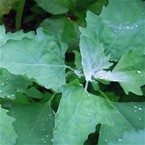Garden2Table – GARDEN2TABLE April 2022

GARDEN2TABLE 2022
By: Cassandra D’Antonio (SEMG 2012)
Foraging for Wild, Native Edible Foods
What is Your Gateway to Wild Foods?
That was a question Brad Lancaster asked multiples times at the New Mexico Land & Water Summit in March, and his answers were energetic, innovative, and inspiring. Brad is a dynamic teacher, consultant, and designer of regenerative systems that sustainably enhance local resources and our global potential; the author of the award-winning, best-selling book series Rainwater Harvesting for Drylands and Beyond; and creator of the website www.HarvestingRainwater.com. He is also the co-founder of Neighborhood Foresters, which strives to repopulate Tucson’s urban core with rain-irrigated, native food forests.
Through his work with Neighborhood Foresters, Lancaster and his brother’s family harvest about 100,000 gallons of rainwater a year on an eighth-acre urban lot and adjoining right-of-way in downtown Tucson, which is located within the Sonoran Desert and receives just around 11 inches of annual rainfall. This harvested water is then turned into living air conditioners of food-bearing shade trees, abundant gardens, and a thriving landscape incorporating wildlife habitat, beauty, medicinal and edible plants, and more. This work also inspired the Eat Mesquite and More, a cookbook which encourages a renaissance of “wild agriculture,” and “celebrates native food forests of the Sonoran Desert and beyond with over 170 recipes featuring wild, indigenous foods, including mesquite, acorn, barrel cactus, chiltepin, cholla, desert chia, desert herbs and flowers, desert ironwood, hackberry, palo verde, prickly pear, saguaro, wolfberry, and wild greens.” Bake sales are regularly held in downtown Tucson using recipes that highlight indigenous, wild foods. Eat Mesquite and More: A Cookbook for Sonoran Desert Foods and Living by Desert Harvesters – Rainwater Harvesting for Drylands and Beyond by Brad Lancaster (harvestingrainwater.com)
Wildcrafting in New Mexico
While doing research on native foods and wild agriculture in New Mexico, I came across several articles, blogs, and websites about “wildcrafting,” a term I hadn’t heard of before. According to Wikipedia: Wildcrafting (also known as foraging) is the practice of harvesting plants from their natural, or ‘wild’ habitat, primarily for food or medicinal purposes. It applies to uncultivated plants wherever they may be found and is not necessarily limited to wilderness areas. And it appears that this traditional fine art is very much alive and well in New Mexico through tours, workshops, groups, and even cooking classes. According to an article in Taos News, spring and early summer are a fine time to go wildcrafting in Northern New Mexico. And to successfully wildcraft, it is important to know where and in which seasons to find certain herbs and edible plants and the sometimes very short windows of time when they should be gathered so they are at their peak. So, let’s explore some of the edible wild plants New Mexico has to offer.
Wild Asparagus: Let’s begin with wild asparagus because it is synonymous with Spring, and it is at its tender best when harvested early. According to hunter, angler, gardener, and chef blogger Hank Shaw (Hunter Angler Gardener Cook – Hank Shaw’s Wild Food Recipes (honest-food.net), who wrote an entire post on Foraging for Wild Asparagus, wild asparagus is most often found in saline or alkaline soils and soil moisture is important: “Asparagus doesn’t want its feet wet, but wants to be close enough to get the benefit. In the arid West, you will need to focus on marsh edges, irrigation ditches and near cattle ponds or sloughs and streams. “In northern New Mexico, wild asparagus loves growing near some of the Taos Valley acequias, though finding it requires a sharp eye, a bit of walking, and some luck because it can be sometimes hard to spot amid tall grass or brush near the irrigation ditches.
Purslane: An annual with small succulent leaves and yellow flowers, purslane grows best in hot, sunny, dry places: in the cracks of sidewalks, a weed in your garden, and along gravel roads and sunny trails. When eaten raw, this plant is crunchy and tart, and its young leaves make a great addition to sandwiches and salads. Considered a superfood, it is packed with vitamins and minerals, including vitamins A, C, and E, antioxidants, and omega-3 fatty acids. Depending on growing conditions, purslane can be found and harvested between June and September.
Quelite (aka lamb’s-quarter or wild spinach): Quelite or lamb’s-quarter is considered a weed in North America, but in other parts of the world it’s cultivated as a vegetable. Its foliage is diamond shaped, and the undersides of the leaves are white. Both the leaves and stems are edible, with a mild flavor, similar to spinach. These plants contain a fair amount of vitamins and minerals, including vitamins A and C, and iron, folate, magnesium, and phosphorous. Look for it in June and July, in sunny fields and in your yard and garden. Strip the leaves off the stems and use them as you would spinach.
Prickly pears: This cactus is common in both cultivated and wild landscapes in north-central New Mexico, where they grow in hot, dry conditions and in poor, sandy soils. To cook with prickly pears, look for young, large paddles with the fewest spines. Use a knife or vegetable peeler to remove the spines and glochids and then slice up the pads and add them to egg dishes or stir-fries. You can find and harvest the ripened fruits of the prickly pear from August through October. Use prickly pear juice to make jellies, marinades, syrups, cocktails, and sorbet.
There are many more edible (and medicinal) plants growing in the wild here in New Mexico, and in your own yard and gardens, such as chokecherries, sumac, juniper berries, amaranth, mallow, and dandelions, just to name a few. For more information regarding wild, edible plants of New Mexico, check out Charles Kane’s book Wild Edible Plants of New Mexico. Or Ellen Zachos’ website Backyard Forager (thinkific.com), which is all about how to harvest and cook with wild edible plants and mushrooms and includes an online mini foraging course for beginners.
Spring Vegetables and Recipes
So many of our favorite fruits and vegetables are in season this time of year: leeks, sugar snap peas, radishes, fennel, asparagus, artichokes, strawberries, cherries, mushrooms, and many more. And we have you covered with dozens of spring recipes at the following links:
63 Side Dish Recipes for Your Spring Dinner Table | Epicurious | Epicurious
40 Fast Spring Vegetable Recipes—the Perfect Seasonal Sides (tasteofhome.com)
30 Vibrant Healthy Spring Recipes! | Feasting At Home
25 Best Spring Recipes | Cooking Light
